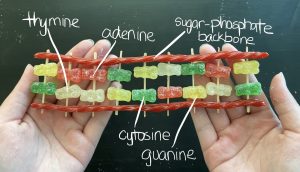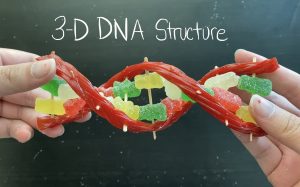7 DNA Modeling
Erin Heapy; Liam McGouldrick; and Mary Huynh
WHAT MAKES YOU WHO YOU ARE | DNA MODELING
Age Group: 2nd-3th grade
Key Words: 3D Modeling, DNA Molecule, DNA Structure, Cells
Time Commitment: 30 minutes
In this activity, you will build a 3D model of DNA structures using edible materials. You will learn about what DNA is, why it is important, and what it looks like inside each and every single one of your cells. After you’re done, you can disassemble the model and eat it!
INTRODUCTION
Do you ever wonder what makes you you? Why do you have 10 fingers? Why do you have two eyes, and not four or seven? The answer is because inside of you is a map with detailed instructions about how your body should grow! This map is coded inside a very special molecule called “DNA”.
DNA lives inside our cells. Our bodies are made of tens of trillions of them! They’re like little legos, except alive. The DNA is kept inside the nucleus, or “brain,” of the cell.
Each molecule of DNA is made of two long chains interwoven with each other and connected by “ladder rungs” of 4 different types: A, G, T, and C. These ladder rungs are called base pairs! A and T are friends, and G and C as well. They bond together with their friend. The order in which they’re bonded is the instruction! In other words, the order of base pairs is the map your body uses to grow and develop.
So how do you have ten fingers and two eyes? Because our DNA says so 🙂
ACTIVITY
We will be making an edible 3D structure of DNA, called a “double helix”. The final product will look similar to a ladder that is twisted.
Materials Required
- Sturdy, string-like candy (licorice, Fruity Nerd Ropes, Rainbow Airhead Extremes)
- Small candies in a variety of at least 4 colors (mini marshmallows, gummy bears, jelly beans)
- Toothpicks
Step-By-Step Instructions (example using licorice and gummy bears)
1) Get two strands of licorice (these are your sugar-phosphate backbones)
2) Pick only four colors of gummy bears and assign each color either Adenine, Thymine, Guanine, or Cytosine
3) Adenine goes with Thymine and Cytosine goes with Guanine, so place those gummy bears in pairs.
-
- For example:
- Adenine = red gummy bear
- Thymine = white gummy bear
- Cytosine = green gummy bear
- Guanine = yellow gummy bear
- So for example, the red gummy bear would be paired with the white gummy bear and the green gummy bear would be paired with the yellow gummy bear
- For example:
4) Using the toothpicks, pierce the pairs of gummy bears together, similar to a skewer.
5) Align the skewered gummy bears side by side, equally spaced apart, leaving some room at the end of the toothpicks for licorice attachment.
6) Attach the two strands of licorice on each end of the gummy bear skewers, adding and aligning each additional skewer beneath the previous one until the end of the strand is reached.
7) Twist the structure to see what DNA looks like in 3D
8) You can now disassemble and eat your DNA model!
Example of a Completed Project:


ADDITIONAL BACKGROUND INFORMATION (an in-depth look for parents)
The human genome is made up of hundreds of millions of nucleotides condensed together into 23 chromosomes. These 23 chromosomes exist in the nuclei of each and every one of our ~37.2 trillion cells! The nucleotides that make up the chromosomes are made up of 3 parts: a phosphate group, a pentose sugar, and a nitrogenous base. In this project, your child will recreate a tiny section of DNA using edible materials. The string-like candy represents the combination of the phosphate group and pentose sugar, which build the backbone of DNA. The singular candies represent the nitrogenous bases, which there are four of: adenine, guanine, cytosine, and thymine. Due to spacing and bond formation between the nitrogenous bases, adenine can only bind with thymine and cytosine can only bind with guanine. All of these parts come together to make a structure that looks very similar to a ladder. The ladder is twisted due to interactions between the DNA molecules and the water surrounding it.
All of our genes are made up of these structures, which encode proteins that make us who we are, what we are made of, and what we look like. Therefore it is important to expose young children to DNA and its structure, the building blocks of life and basis of human biology, which is hopefully achieved through the creation of this fun, edible project!
